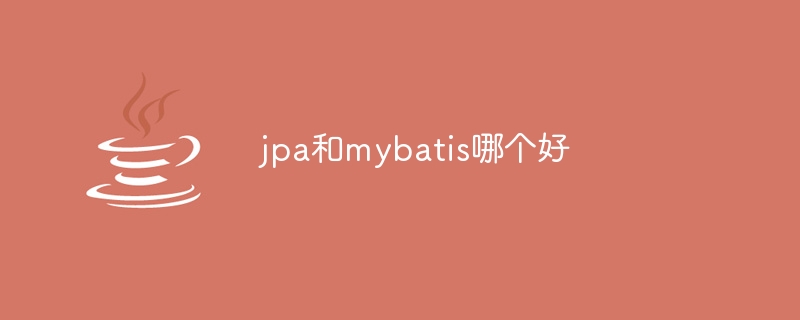
Choosing JPA or MyBatis depends on specific needs and preferences. Both JPA and MyBatis are Java persistence layer frameworks, and both provide the function of mapping Java objects to database tables. If you need a mature framework that supports cross-database operations, or the project has already adopted JPA as a persistence layer solution, continuing to use JPA may be a better choice. If you want higher performance and more flexible SQL writing capabilities, or are looking for a solution that is less dependent on the database, MyBatis is more suitable.

The operating system for this tutorial: Windows 10 system, DELL G3 computer.
JPA and MyBatis are both Java persistence layer frameworks. They both provide the function of mapping Java objects to database tables. However, there are some differences in design and use between the two, and which one is better for your project depends on your specific needs.
JPA (Java Persistence API)
JPA is a Java-based object-oriented domain model dedicated to solving business logic problems. JPA is centered on the object-oriented domain model, supports the object-oriented inheritance concept, and supports inheritance mapping, polymorphic association and polymorphic query. It provides a set of standard APIs, simplifying developers' workload in writing database-related code and improving development efficiency. At the same time, JPA supports operations across multiple databases, and developers can switch between different databases without modifying the code. In addition, JPA also supports customized SQL statements, but it is slightly less flexible than MyBatis.
MyBatis
MyBatis is a framework that can flexibly write SQL statements. It is more database-oriented, so it requires hand-written SQL statements. It can write and optimize SQL statements according to your ideas. MyBatis completely avoids almost all JDBC code and manual setting of parameters and obtaining result sets, which is more convenient than JDBC. In addition, MyBatis provides high flexibility and can implement various complex query operations through customized SQL statements. The main difference between MyBatis and JPA is the design philosophy. MyBatis is more process-oriented, while JPA takes object-oriented to the extreme.
Comparison of advantages and disadvantages
1. Degree of automation: JPA/Hibernate is more automated while MyBatis is more flexible. In some cases, MyBatis performs better than JPA/Hibernate.
2. Performance: The performance of MyBatis is usually better than JPA/Hibernate, especially when processing complex queries. This is because MyBatis avoids almost all JDBC code and manual setting of parameters and obtaining result sets.
3. Database independence: JPA supports operations across multiple databases, while MyBatis relies more on the dialect of a specific database. Therefore, if you plan to switch between different databases, JPA may be a better choice.
4. Difficulty of learning and using: For beginners, JPA may be easier to get started than MyBatis because its concepts and API are more standard. However, once you master MyBatis' mapping and SQL writing skills, developers may find that it is more flexible and powerful in some aspects.
5. Community and support: Both have a large number of users and active communities. But from a global perspective, MyBatis's community may be more active in some areas.
Summary
Choosing JPA or MyBatis depends on your specific needs and preferences. If you need a mature framework that supports cross-database operations, or your project has already adopted JPA as a persistence layer solution, continuing to use JPA may be a better choice. However, if you need higher performance and more flexible SQL writing capabilities, or you are looking for a solution that is less dependent on the database, then MyBatis may be more suitable for you. The best thing to do is to develop a thorough understanding of both before starting your project and evaluate how they meet your specific needs.
The above is the detailed content of Which one is better, jpa or mybatis?. For more information, please follow other related articles on the PHP Chinese website!
 what is jpa
what is jpa
 mybatis first level cache and second level cache
mybatis first level cache and second level cache
 What is the difference between ibatis and mybatis
What is the difference between ibatis and mybatis
 How to configure database connection in mybatis
How to configure database connection in mybatis
 What is the working principle and process of mybatis
What is the working principle and process of mybatis
 What are the differences between hibernate and mybatis
What are the differences between hibernate and mybatis
 location.reload
location.reload
 java configure jdk environment variables
java configure jdk environment variables




